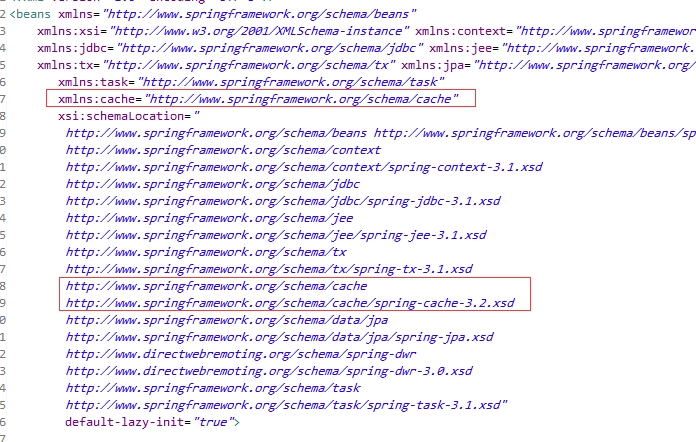pring + ehcache 缓存配置,注解实现
1,spring配置文件修改
xmlns:cache=”http://www.springframework.org/schema/cache”
xsi:schemaLocation 增加
http://www.springframework.org/schema/cache
http://www.springframework.org/schema/cache/spring-cache-3.2.xsd
如图:

内容增加:
<!-- 缓存配置 --><!-- 启用缓存注解功能(请将其配置在Spring主配置文件中) --><cache:annotation-driven cache-manager="cacheManager"/><!-- Spring自己的基于java.util.concurrent.ConcurrentHashMap实现的缓存管理器(该功能是从Spring3.1开始提供的) --> <!-- <bean id="cacheManager" class="org.springframework.cache.support.SimpleCacheManager"> <property name="caches"> <set> <bean name="myCache" class="org.springframework.cache.concurrent.ConcurrentMapCacheFactoryBean"/> </set> </property> </bean> --> <!-- 若只想使用Spring自身提供的缓存器,则注释掉下面的两个关于Ehcache配置的bean,并启用上面的SimpleCacheManager即可 --> <!-- Spring提供的基于的Ehcache实现的缓存管理器 --> <bean id="cacheManagerFactory" class="org.springframework.cache.ehcache.EhCacheManagerFactoryBean"> <property name="configLocation" value="classpath:ehcache.xml"/> </bean> <bean id="cacheManager" class="org.springframework.cache.ehcache.EhCacheCacheManager"> <property name="cacheManager" ref="cacheManagerFactory"/> </bean>
2,ehcache.xml 配置
<?xml version="1.0" encoding="UTF-8"?><ehcache xmlns:xsi="http://www.w3.org/2001/XMLSchema-instance"
xsi:noNamespaceSchemaLocation="ehcache.xsd" updateCheck="false">
<diskStore path="Java.io.tmpdir"/>
<!--
强制默认缓存配置。这些设置将应用于缓存
programmtically使用缓存管理器创建添加(字符串cachename)。
-->
<!--
name:缓存名称。
maxElementsInMemory:缓存最大个数。
eternal:对象是否永久有效,一但设置了,timeout将不起作用。
timeToIdleSeconds:设置对象在失效前的允许闲置时间(单位:秒)。仅当eternal=false对象不是永久有效时使用,可选属性,默认值是0,也就是可闲置时间无穷大。
timeToLiveSeconds:设置对象在失效前允许存活时间(单位:秒)。最大时间介于创建时间和失效时间之间。仅当eternal=false对象不是永久有效时使用,默认是0.,也就是对象存活时间无穷大。
overflowToDisk:当内存中对象数量达到maxElementsInMemory时,Ehcache将会对象写到磁盘中。
diskSpoolBufferSizeMB:这个参数设置DiskStore(磁盘缓存)的缓存区大小。默认是30MB。每个Cache都应该有自己的一个缓冲区。
maxElementsOnDisk:硬盘最大缓存个数。
diskPersistent:是否缓存虚拟机重启期数据 Whether the disk store persists between restarts of the Virtual Machine. The default value is false.
diskExpiryThreadIntervalSeconds:磁盘失效线程运行时间间隔,默认是120秒。
memoryStoreEvictionPolicy:当达到maxElementsInMemory限制时,Ehcache将会根据指定的策略去清理内存。默认策略是LRU(最近最少使用)。你可以设置为FIFO(先进先出)或是LFU(较少使用)。
clearOnFlush:内存数量最大时是否清除。
-->
<defaultCache maxElementsInMemory="10000"
eternal="false"
timeToIdleSeconds="120"
timeToLiveSeconds="120"
overflowToDisk="true"
maxElementsOnDisk="10000000"
diskPersistent="false"
diskExpiryThreadIntervalSeconds="120"
memoryStoreEvictionPolicy="LRU"
/>
<cache name="dictCache"
maxElementsOnDisk="10000"
maxElementsInMemory="10000"
eternal="true"
transactionalMode="off">
</cache></ehcache>
3.Service方法使用@Cacheable注解
@Cacheable(value="dictCache", key="#dictName")
public List<Dict> getByDictName(String dictName){
return dao.findByDictName(dictName);
}
value 对应ehcache.xml 中的name
如果没错可以测试一把,多次调用方法,应该会有第一次打印sql语句
Tips:
@Cacheable注解可以用在方法或者类级别。当他应用于方法级别的时候,就是如上所说的缓存返回值了。当应用在类级别的时候,这个类的所有方法的返回值都将被缓存。
@CacheEvict 注解可以用在数据库记录删除时同时删除缓存
@CachePut 注解可以在更新的记录时也更新缓存
- 本文固定链接: http://www.ypbj.cc/post/143.html
- 转载请注明: yupang 于 余胖笔记 发表

《本文》有 0 条评论